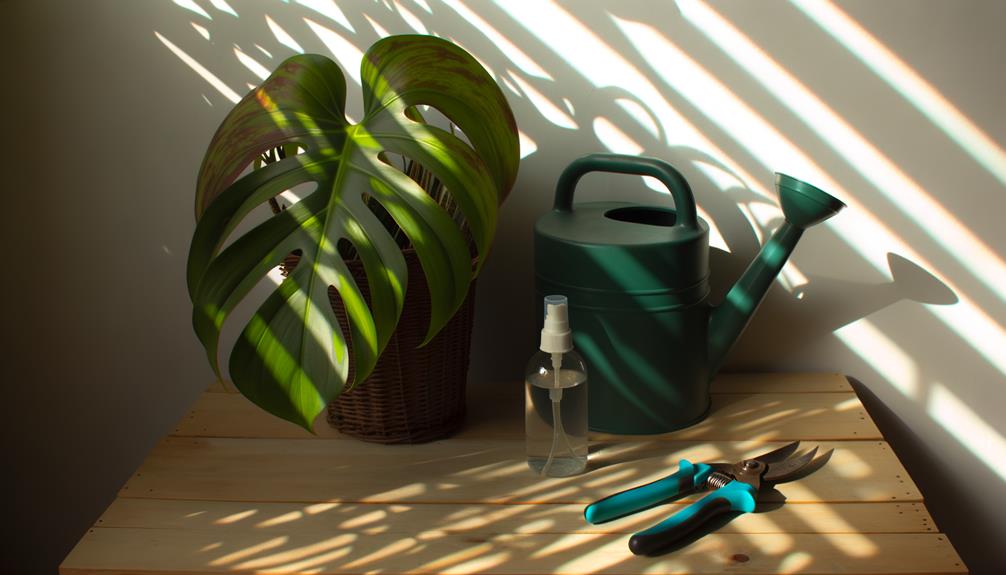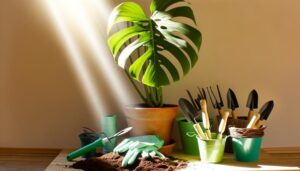Monstera Standleyana Leaf Care
Guarantee your Monstera standleyana has healthy leaves by placing it in bright, indirect light. Position the plant near an east or west-facing window to avoid direct sunlight, which can cause photodamage.
Maintain a temperature between 65-80°F to support enzymatic functions. Keep the relative humidity around 60-80% using misting or a humidifier to prevent leaf desiccation.
Water thoroughly but check soil moisture to avoid waterlogged roots. Use a well-draining soil mix with pH 5.5-7.0 for prime nutrient uptake.
Regularly monitor for pests like spider mites and aphids and apply neem oil if needed. Discover more advanced techniques to optimize your plant thrives.

Key Takeaways
- Maintain bright, indirect light to prevent leaf damage and promote healthy growth.
- Ensure 60-80% humidity to prevent leaf desiccation and brown edges.
- Water thoroughly when soil is dry, adjusting frequency based on seasons and humidity.
- Prune yellow or brown leaves to encourage new growth and prevent pest infestations.
- Use well-draining soil with proper pH and nutrient balance for optimal leaf health.
Light Requirements
Monstera standleyana thrives in bright, indirect light, which mimics its natural understory habitat in tropical rainforests. You should position it near an east or west-facing window, where it can receive filtered sunlight.
Direct sunlight can cause photoinhibition, leading to chlorophyll degradation and leaf scorch. On the other hand, inadequate light results in etiolation, where stems elongate excessively and leaves become smaller and paler.
Using a light meter, aim for 1000-2000 foot-candles to maintain prime photosynthesis rates. Artificial grow lights can supplement natural light, especially in lower-light environments. Keep the lamp around 12-18 inches away from the plant to prevent thermal injury.
Proper lighting ensures sturdy growth, maintains variegation, and supports overall plant health.
Ideal Temperature
Maintaining an ideal temperature range of 65-80°F (18-27°C) is crucial for Monstera standleyana, as temperatures outside this range can impede metabolic processes and hinder growth. To achieve peak development, monitor ambient temperature closely using a calibrated thermometer.
Below 65°F (18°C), enzymatic activity slows, leading to stunted growth and potential chlorosis. Conversely, temperatures exceeding 80°F (27°C) can cause cellular stress, resulting in leaf scorch and transpiration imbalance.
Ensure you evade sudden temperature fluctuations, which can shock the plant, disrupting its physiological equilibrium. Utilize climate control devices like heaters or fans to maintain consistent conditions.
Humidity Levels
Maintaining ideal humidity levels is essential for Monstera Standleyana, with an ideal range of 60-80% relative humidity.
You can increase humidity using methods such as misting, utilizing a humidifier, or placing the plant on a pebble tray with water.
Consistent humidity prevents leaf desiccation and promotes healthy growth.
Ideal Humidity Range
Achieving the best moisture range of 60-80% is crucial for the health and vitality of Monstera Standleyana leaves. This tropical plant flourishes in high moisture environments, which replicates its natural habitat. Low moisture can lead to the leaves drying up, resulting in brown edges and stunted growth.
To maintain an ideal moisture level:
- Monitor Moisture: Utilize a hygrometer to consistently measure the surrounding moisture near your plant.
- Avoid Drafts: Keep the plant away from air vents and breezy windows, as these can greatly diminish moisture levels.
- Proper Watering: Maintain consistent soil moisture without overwatering to support overall plant hydration.
- Grouping Plants: Position multiple plants close together to create a small-scale environment with increased moisture through transpiration.
Comprehending these factors ensures your Monstera Standleyana thrives.
Increasing Humidity Methods
To enhance the humidity around your Monstera Standleyana, consider using a humidifier, which can consistently add moisture to the air. A humidifier works by converting water into steam or mist, thereby increasing the ambient relative humidity. For best results, aim for a relative humidity level of 60-70%.
Alternatively, you can use a pebble tray. Fill a shallow tray with water and pebbles, then place the plant pot on top, making sure the pot base isn't submerged. This method utilizes the principles of evaporation to boost local humidity.
Additionally, grouping plants together creates a microenvironment with higher humidity due to collective transpiration.
Lastly, periodic misting can temporarily increase humidity, but it's less effective than the previously mentioned methods.
Watering Schedule
Appropriate hydration is crucial for the best growth of Monstera Standleyana, requiring a diligent watering schedule that balances moisture levels without causing waterlogged roots. You should monitor soil moisture and adopt a precise watering regimen.
Here are key steps to ensure ideal hydration:
- Check Soil Moisture: Insert your finger 1-2 inches into the soil. Water only if it feels dry to the touch.
- Water Thoroughly: Apply water until it drains through the bottom. This ensures even distribution and prevents salt buildup.
- Seasonal Adjustments: Increase watering frequency in summer and reduce it in winter, aligning with the plant's growth cycle.
- Humidity Consideration: High ambient humidity can reduce transpiration rates, necessitating less frequent watering.
Soil Preferences
When considering soil preferences for your Monstera Standleyana, you'll need to focus on achieving an ideal soil composition that includes organic matter and perlite for improved drainage and aeration.
It's important to maintain a slightly acidic to neutral pH level, ideally ranging between 5.5 and 7.0, to support best nutrient uptake.
Ensuring proper drainage is key to preventing root rot while promoting healthy growth.
Ideal Soil Composition
Monstera Standleyana thrives in well-draining, aerated soil that mimics its natural tropical habitat, often benefiting from a mix containing peat, perlite, and orchid bark. Peat moss retains moisture while providing organic matter. Perlite enhances drainage and aeration, preventing root rot. Orchid bark adds structure, promoting airflow around roots.
To create the ideal soil mix, consider the following components:
- Peat Moss (30%) – High moisture retention, acidic pH levels.
- Perlite (20%) – Lightweight, improves drainage and aeration.
- Orchid Bark (30%) – Increases porosity, supports root health.
- Compost (20%) – Nutrient-rich, enhances soil fertility.
This precise blend guarantees your Monstera Standleyana has the perfect environment for robust growth, mimicking the well-drained, nutrient-rich soils of tropical forests.
Drainage and Aeration
Securing proper drainage and aeration is crucial for preventing waterlogged roots and promoting healthy oxygen exchange in the soil matrix.
You should use a well-draining soil mix, incorporating components like perlite, orchid bark, and sphagnum moss. These elements increase porosity and facilitate the rapid evacuation of excess water, mitigating the risk of root rot.
Additionally, they create air pockets within the soil, enhancing root respiration and microbial activity. Avoid dense soils, as they impede gas exchange and retain moisture excessively.
Regularly check the pot's drainage holes to make sure they're not obstructed, and consider using a pot with aeration holes.
Ph Levels
To maintain ideal growth, aim to keep the soil's acidity level between 5.5 and 7.0. This range ensures peak nutrient uptake for Monstera Standleyana, as extreme acidity levels can lead to nutrient deficiencies or toxicities.
To manage soil acidity effectively:
- Test Regularly: Use a soil acidity meter or testing kit to monitor levels consistently.
- Amend Soil: Add lime to raise acidity or sulfur to lower it, following manufacturer guidelines.
- Organic Matter: Incorporate compost or peat moss to naturally balance acidity levels.
- Water Quality: Use distilled or rainwater to avoid altering soil acidity with tap water's potential alkalinity.
Fertilizing Tips
When fertilizing Monstera Standleyana, apply a balanced, water-soluble fertilizer with a 20-20-20 NPK ratio during the growing season to promote robust leaf development and overall plant health. Use this fertilizer bi-weekly, ensuring the soil is moist before application to prevent root burn. The nitrogen component enhances chlorophyll production, which intensifies leaf coloration. Phosphorus supports root growth and flowering, while potassium fortifies cell walls, enhancing disease resistance.
| Nutrient | Benefit |
|---|---|
| Nitrogen | Promotes lush, green leaves |
| Phosphorus | Stimulates root growth |
| Potassium | Enhances disease resistance |
| Calcium | Strengthens cell walls |
| Magnesium | Essential for photosynthesis |
Always dilute the fertilizer to half the recommended strength to avoid over-fertilization, which can lead to nutrient toxicity.
Pruning Techniques
After mastering fertilization, you'll need to comprehend precise pruning techniques to maintain your Monstera Standleyana's health and aesthetic.
Pruning helps control the plant's growth, removes damaged leaves, and promotes new, healthy foliage. Here are four key steps:
- Sanitize Tools: Use isopropyl alcohol to sterilize pruning shears. This prevents pathogen transmission.
- Identify Target Areas: Focus on yellow, brown, or diseased leaves. Also, prune leggy stems to encourage bushier growth.
- Make Clean Cuts: Cut just above a node (where leaves attach to the stem). This promotes new growth from that node.
- Dispose of Debris: Remove all pruned material to avoid pest infestations and fungal issues.
These steps guarantee robust, attractive Monstera Standleyana foliage.
Repotting Guide
Repotting your Monstera Standleyana involves carefully transferring the plant to a larger container to accommodate root growth and ensure best nutrient absorption. Begin by selecting a pot that's 2-3 inches wider in diameter than the current one, making sure it has adequate drainage holes.
Gently remove the plant, avoiding root damage. Examine the root system for signs of root rot or disease, and trim any affected areas with sterilized pruning shears. Prepare a well-draining potting mix, ideally a combination of peat moss, perlite, and orchid bark, to mimic the plant's native tropical environment.
Place the Monstera in the new pot, fill in with soil, and water thoroughly. This process promotes optimal growth and prevents nutrient deficiencies.
Common Pests
When caring for your Monstera Standleyana, you'll need to identify common pests such as spider mites, aphids, and mealybugs, which can cause significant damage.
Implementing pest prevention strategies, including regular inspections and maintaining ideal humidity levels, can help mitigate infestations.
For natural pest solutions, consider using neem oil or insecticidal soap to manage and control these pests effectively.
Identifying Common Pests
To effectively manage Monstera standleyana leaf care, you must first identify common pests like spider mites, mealybugs, and scale insects. These pests compromise plant health through severe sap extraction, chlorosis, and potential transmission of plant pathogens.
- Spider Mites (Tetranychus urticae): Minute arachnids that create webbing on the leaf undersides. Look for stippling and yellowing of foliage.
- Mealybugs (Pseudococcidae): Cotton-like masses found in leaf axils and stems. These insects secrete honeydew, promoting sooty mold growth.
- Scale Insects (Coccoidea): Immobile, shell-covered pests adhering to stems and leaves. They cause chlorotic spots and weakened plant vigor.
- Aphids (Aphidoidea): Small, soft-bodied insects that cluster on new growth and excrete honeydew, attracting ants and fostering fungal issues.
Recognizing these pests promptly ensures timely intervention and preserves your Monstera's essentiality.
Pest Prevention Tips
Implementing integrated pest management (IPM) strategies is essential for preventing infestations of spider mites, mealybugs, scale insects, and aphids on your Monstera standleyana.
Start by regularly inspecting your plant's foliage for early signs of pest activity. Utilize biological control agents such as predatory insects to naturally suppress pest populations.
Maintain ideal environmental conditions, including proper humidity and air circulation, to deter pest colonization. Employ mechanical removal methods by wiping leaves with a damp cloth to physically dislodge pests.
Additionally, consider quarantining new plants to prevent introducing pests to your existing collection. Consistently monitor and document pest activity to adapt your IPM strategies effectively.
Natural Pest Solutions
Harnessing natural pest solutions can effectively manage common pests like spider mites, mealybugs, and aphids on your Monstera standleyana through environmentally-friendly methods. These insects can cause chlorosis and stunted growth by disrupting the plant's photosynthesis.
To combat these pests, consider the following options:
- Neem Oil: Apply neem oil, a natural insecticide, to your plant's leaves. Its azadirachtin component disrupts pest feeding and reproduction.
- Insecticidal Soap: Use insecticidal soap to suffocate pests. It breaks down their cell membranes, leading to dehydration.
- Beneficial Insects: Introduce predatory insects like ladybugs or lacewings, which naturally consume harmful pests.
- Diatomaceous Earth: Dust leaves with diatomaceous earth. This abrasive powder damages the exoskeletons of insects, causing them to dehydrate and die.
Disease Prevention
Ensuring the prevention of diseases in Monstera Standleyana involves maintaining ideal humidity levels, proper watering practices, and vigilant monitoring for early signs of fungal or bacterial infections. Keep the humidity around 60-70% to prevent fungal growth. Avoid overwatering, as waterlogged soil can lead to root rot caused by pathogens like Pythium and Phytophthora.
| Symptom | Possible Cause | Solution |
|---|---|---|
| Yellowing Leaves | Overwatering | Improve drainage, reduce water |
| Black Spots | Fungal Infection | Apply fungicide, increase airflow |
| Wilting | Root Rot | Repot with fresh soil, trim affected roots |
| Leaf Spots | Bacterial Infection | Use bactericide, isolate plant |
Regularly inspect your Monstera Standleyana for any abnormalities and take swift action to mitigate potential issues.
Leaf Cleaning
To maintain the health and appearance of your Monstera Standleyana, regularly clean its leaves to remove dust and debris that can obstruct photosynthesis. This process guarantees optimal light absorption and gas exchange, essential for healthy growth.
Follow these steps:
- Dilute Soap Solution: Mix a few drops of mild liquid soap in a gallon of lukewarm water to create a non-toxic cleaning solution.
- Soft Cloth or Sponge: Use a soft cloth or sponge soaked in the solution to gently wipe each leaf, ensuring you reach the undersides.
- Rinse with Water: Thoroughly rinse the leaves with clean water to remove any soap residue that might clog stomata.
- Dry Thoroughly: Pat the leaves dry with a soft towel to prevent fungal infections due to excess moisture.
Propagation Methods
After thoroughly cleaning your Monstera Standleyana leaves, you can focus on propagation methods to expand your collection and share this unique plant with others.
Begin by selecting a healthy stem with at least one node and an aerial root. Using sterilized pruning shears, make a clean cut just below the node. Place the cutting in water, ensuring the node is submerged, or plant it directly in moist, well-draining soil. Maintain high humidity and indirect light to encourage root development. Roots typically form within 3-4 weeks.
Once established, transplant the cutting into a suitable container with a balanced potting mix. By following these steps, you'll successfully propagate your Monstera Standleyana and enjoy its lush foliage.
Conclusion
Caring for your Monstera standleyana isn't just a chore; it's a science. Guarantee it basks in bright, indirect light, and maintain temperatures between 65-80°F.
Keep humidity levels high, and water when the top inch of soil is dry. Use well-draining, aerated soil, and stay vigilant against pests and diseases.
Clean leaves regularly, and propagate through stem cuttings. With precise care, your plant will flourish, transforming your space into a green oasis.
It's a botanical symphony you orchestrate.






